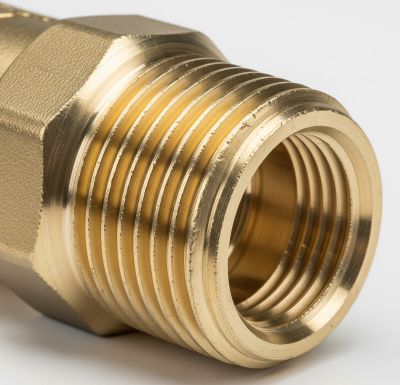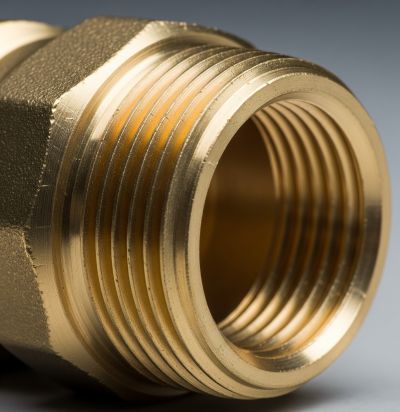When it comes to plumbing, getting the right thread type is essential for creating safe, leak-free connections. However, the terminology surrounding thread types—especially NPT, FPT, and MPT, can be confusing. Are they interchangeable? Do they mean the same thing? And which one should you use?
In this guide, we’ll break down what each thread type means, how they differ, and when to use them in your plumbing projects.
The Basics of Pipe Threads
Pipe threads are the spiral grooves cut into pipe fittings that allow them to be screwed together. They are essential for creating mechanical connections between pipes and ensuring fluid-tight seals.
Pipe threads are designed to create pressure-tight seals. If you mix incompatible thread types, you risk leaks, breaks, or system failure—especially in high-pressure environments.
Tapered vs Straight Threads:
➡️ Tapered threads gradually decrease in diameter. When tightened, they form a seal through compression.
➡️ Straight threads remain the same diameter and typically rely on O-rings or gaskets for sealing.
Male vs Female Threads:
➡️ Male threads are external and screw into female threads.
➡️ Female threads are internal and receive the male threads.
Proper threading is critical for safety, efficiency, and reliability in any plumbing system.
What is NPT?
NPT stands for National Pipe Thread. It’s the most commonly used pipe thread type in North America.
Characteristics:
1. Tapered design that narrows toward the end.
2. Requires thread sealant (like PTFE tape or pipe dope) to ensure a tight, leak-proof connection.
3. Designed to seal by interference fit—the threads compress against each other.
4. Governed by ANSI/ASME B1.20.1 standard.
Is NPT thread the same as BSP?
No. BSP (British Standard Pipe) and NPT have different thread angles and pitch. They are not compatible.
Are NPT and FIP compatible?
Yes, if the FIP is based on NPT threading (which is often the case in the U.S.). FIP is essentially FPT using NPT standard threads.
What is MPT?
MPT stands for Male Pipe Thread, and it usually refers to Male NPT.
Characteristics:
1. External, tapered threads.
2. Screws into FPT (female) fittings.
3. Common labeling includes MPT, MNPT, or NPT male.
Commonly used for:
1. Pipe nipples
2. Valves
3. Hose adapters
What is FPT?
FPT stands for Female Pipe Thread, typically meaning Female NPT.
Characteristics:
1. Internal, tapered threads.
2. Designed to receive MPT fittings.
3. Also labeled as FPT, FNPT, or NPT female.
Found in:
1. Couplers
2. Pipe connectors
3. End caps
4. Valves
Is FPT compatible with NPT?
Yes, FPT uses NPT threading—so it connects with any NPT male (MPT) component.
What’s the difference between MPT, FPT, and NPT?
➡️ NPT is the thread standard (National Pipe Thread).
➡️ MPT and FPT describe the gender of the connection.
➡️ Both MPT and FPT follow NPT thread specifications.
Quick Comparison Table
|
Feature |
NPT |
MPT (MNPT) |
FPT (FNPT) |
|
Stands for |
National Pipe Thread |
Male Pipe Thread |
Female Pipe Thread |
|
Thread Type |
Tapered |
Tapered (external) |
Tapered (internal) |
|
Gender |
Neutral/General |
Male |
Female |
|
Common Use |
General standard |
Screws into FPT |
Accepts MPT |
How to Match and Use the Right Threads
To ensure compatibility:
➡️ Always pair MPT with FPT.
➡️ NPT is the underlying thread standard used by both MPT and FPT.
➡️ Check product specifications, especially when using different materials (e.g., brass fitting to PVC pipe).
➡️ Use thread sealants like Teflon tape or pipe compound with NPT threads to prevent leaks.
Common Mistakes to Avoid
➡️ Mismatching thread types – Trying to connect MPT to another MPT will not work.
➡️ Over-tightening – Can damage threads or cause leaks.
➡️ Mixing NPT with BSP – These have different thread angles and are not compatible.
➡️ Skipping sealant – NPT threads are not self-sealing and require a sealant for a proper seal.
FAQs
Q: What’s the difference between NPT and MPT?
A: NPT is the thread standard; MPT is a male fitting that uses NPT threads.
Q: Can MPT be connected to NPT?
A: Yes. MPT is a type of NPT thread (male). It connects to FPT (female NPT).
Q: Is FPT the same as NPT?
A: FPT is a female version of the NPT standard. So yes, FPT uses NPT threads internally.
Q: How do I identify the thread type I have?
A: Use a thread pitch gauge or compare it to known NPT fittings. If in doubt, consult the manufacturer or a plumbing professional.
Conclusion
Understanding the difference between NPT, MPT, and FPT is essential for any plumbing project.
➡️ NPT is the tapered thread standard.
➡️ MPT and FPT refer to male and female fittings using NPT threads.
➡️ Always match male and female threads, use appropriate sealants, and check specs to ensure compatibility.
Taking the time to understand thread types can save you from costly mistakes, leaks, and rework. Whether you’re a DIYer or a professional plumber, knowing how to work with NPT, MPT, and FPT threads will make your projects smoother and more reliable.
Post time: Jul-09-2025




